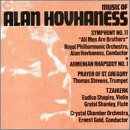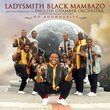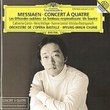| All Artists: Alan Hovhaness, Ernest Gold, Royal Philharmonic Orchestra, Crystal Chamber Orchestra Title: Music of Alan Hovhaness Members Wishing: 1 Total Copies: 0 Label: Crystal Records Release Date: 8/19/1993 Genre: Classical Styles: Forms & Genres, Concertos, Historical Periods, Modern, 20th, & 21st Century, Instruments, Brass, Symphonies Number of Discs: 1 SwapaCD Credits: 1 UPCs: 009414780126, 000941478012 |
Search - Alan Hovhaness, Ernest Gold, Royal Philharmonic Orchestra :: Music of Alan Hovhaness
 | Alan Hovhaness, Ernest Gold, Royal Philharmonic Orchestra Music of Alan Hovhaness Genre: Classical
|
Larger Image |
CD DetailsSimilarly Requested CDs
|
CD ReviewsA Vision of Eternal Peace Thomas F. Bertonneau | Oswego, NY United States | 06/05/2003 (4 out of 5 stars) "I made the acquaintance of Alan Hovhaness' Symphony No. 11, "All Men Are Brothers" (1961) via the Unicorn LP reissue, in the mid-1970s, of the slightly earlier Poseidon-label LP produced by the composer himself as part of his bid to convey his music to a wider audience than previously in performances under his own direction. The companion piece on the program was the orchestral fantasy "Fra Angelico." One commentator on Hovhaness writes that his earlier symphonies (in a sequence that eventually entailed some sixty-seven contributions to the genre) tend to be his most distinctive, with Symphony No. 2, "Mysterious Mountain" (1954), providing the pattern. The harmony is modal, the melodies often carry the flavor of the composer's ancestral homeland, Armenia, and the devices are baroque rather than classical. Hovhaness writes chorales, sets of variations, canons, and fugues. The rhythms are often asymmetrical dance-rhythms. Hovhaness sometimes sounds like an Anatolian George Frederick Handel. "All Men Are Brothers" uses the same three-movement plan as "Mysterious Mountain," but it is a longer work, needing about thirty-fives minutes where the earlier score needs only eighteen or twenty. The three movements are (1) "Andante Appassionato", (2) "Allegro Maestoso," and (3) "Andante con Nobilita." The First Movement is something on the order of a chaconne or passacaglia, with a "love theme" (so-called) cycling through the orchestra and appearing, with note-values augmented, in the coda. The Second Movement is sectional, culminating in a fugue. The Third Movement encompasses a fugue but concludes in a solemn and festive chorale. Hovhaness' own program-note invokes a vision of the Buddha for the Third Movement. My description of Hovhaness' music is "serene." Even when the colors momentarily darken and the mood becomes sombre, a wonderful calmness is never far away - a dreamy anticipation of bliss in a better world. The symphony has three companions on the disc. First comes the slight "Armenian Rhapsody No. 1" for strings (1944), then the familiar "Prayer of Saint Gregory" for trumpet and strings (1946), and finally the exotic and imaginative "Tzaikerk" for violin, flute, string orchestra and roto-toms (1946). The word "Tzaikerk" apparently means "evening song" or "serenade" in Armenian. In this ten-minute work, the mood swings from Dionysiac, with roto-toms propelling the music in a wild dance, to quiet and nocturnal, with the violin and flute playing lovely duets against the string-orchestra background. I like the symphony, "All Men Are Brothers," and have listened to it three or four times in the last week. In "Tzaikerk," perhaps because he restricts himself to smaller dimensions, Hovhaness seems to me to distill his compositional spirit - or maybe to concentrate it. "Tzaikerk" has atmosphere aplenty and sticks poignantly in the listener's memory after the music itself has faded away. The orchestra for "All Men Are Brothers" is the Royal Philharmonic and the performance was recorded in London in 1970. Hovhaness conducts. The other performances come from the mid-1970s and employ the Crystal Chamber Orchestra - no doubt an ensemble formed by producer Peter Christ especially for making the LP on which "Tzaikerk" and a number of other smaller pieces first appeared. Ernest Gold is the conductor. This is a wonderful program and affecting music by a man who never cared a whit for musical fashion but who stubbornly - I might say, like the New Englander that he was - insisted on finding his own proper means of expression." The Music Of Alan Hovhanness Tim | CO United States | 10/18/2001 (5 out of 5 stars) "I first heard the Symphony No. 11 several years ago on a FM radio station, I managed to get some it recorded but my attempts to track it down were fruitless until I checked here.Describing music to someone is hard to do, I shall attempt... Hovhanness has his own style which one clearly hears during the different tracks on this CD. The Symphony No. 11 "All Men Are Brothers" at the time it was composed about 1969/70 was a poltical statememtn about the Cold War, Viet Nam, etc. It still works today I think if you dump the overt poltiics of the song. The piece takes you through its own little journey, tenative steps at first and then building over so much as the song develops to the resounding ending."Armenian Rhapsody No. 1" starts off with a deep pulsating melody that builds, weaving it's own charm as it goes forth. When I got the CD I only wanted it for the first track but I found myself being drawn in by the other pieces, like "Armenian Rhapsody No. 1". Once I started playing the CD I found myself becoming totally amazed at the level of complexity and simplicty involved with the composed tracks."Prayer Of St. Gregory" would have to be my second favorite track on the CD. The trumpet work by Thomas Stevens is truely captivating, you'll find yourself wanting to press the back button to listen to it again.All in all I would recommend the CD to someone looking for something a little different."
|

 Track Listings (4) - Disc #1
Track Listings (4) - Disc #1

